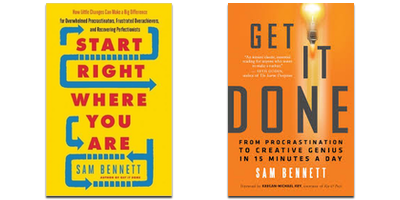“It’s big, R.J.! Big!” says the screenwriter to the old-time Hollywood producer.
Your vision may also have first appeared to you in breathtaking Cinemascope and stereophonic sound.
But you may be paralyzing yourself with the grandiosity of your vision.
Reducing the size of your project might free you up.
So rather than trying to create an international convention of lute lovers complete with presentations, performances, and a trade fair, perhaps you could host a gathering in your home for ten to twelve lute lovers.
This strategy is especially effective for test-driving Big Ideas.
I once had a client named Virginia who had dreams of opening a dance studio. Before she knew it, she was knee-deep in commercial real estate brochures and cumbersome questions about insurance and employee compensation. She was, to put it mildly, discouraged.
After some discussion of what about her initial idea had so engaged her (“working with young artists,” “bringing spirituality and dance together,” and “giving real, practical help and advice — after all, I was a dancer, too — I’ve been there!”), she realized that she could begin by offering a one-day intensive workshop.
Her church would be happy to rent her a space very inexpensively, and suddenly the idea of only having to get fifteen dancers in a room for one day seemed very doable.
Eventually, Virginia did open a dance studio that focused on the intersection of movement and spirituality, but she ended up doing it through her church, thus saving her a million administrative headaches and allowing her to focus on the part of the work that truly inspired her: teaching.
Increase the Scope of Your Project
Maybe you’re stuck because you’re bored. You’ve been thinking too small.
Perhaps rather than trying to sell your jewelry at local craft fairs, it might be more exciting to sell your items online to a global audience of moneyed fans.
Maybe rather than auditioning for the local community chorus, you’d like to book an evening at a piano bar and offer your very own one-person cabaret show.
Try this: Write down a number-related aspect of your goal, then add a zero.
So if you’ve been thinking you’d like to make $10,000, what happens when you open up to the idea of making 100,000?
If you’re working on selling five or ten of something, what does selling fifty or a hundred look like?
Rather than trying to grow your email list a person at a time, what if you found a way to grow your list a thousand people at a time?
Thinking big gets you out of your self-imposed limitations. You stop thinking about what’s possible for you to accomplish on your own, and you start thinking about what’s needed for this quantum leap to happen.
“What does the project need?” is a much more fruitful question than “How do I do this by myself?”
Ask any successful creative entrepreneur her secret and every single one will tell you, “I got out of the way of the vision.”
Action Step
Write down three to five variations in scope of your project and see which size project feels like the best fit.
(Note: Don’t worry about what you think you are capable of doing; just pick the one that makes your heart go thump thump thump and live with the idea for a while.)
After you’ve done the exercise, come back and leave a comment. I would love to see what you came up with!

